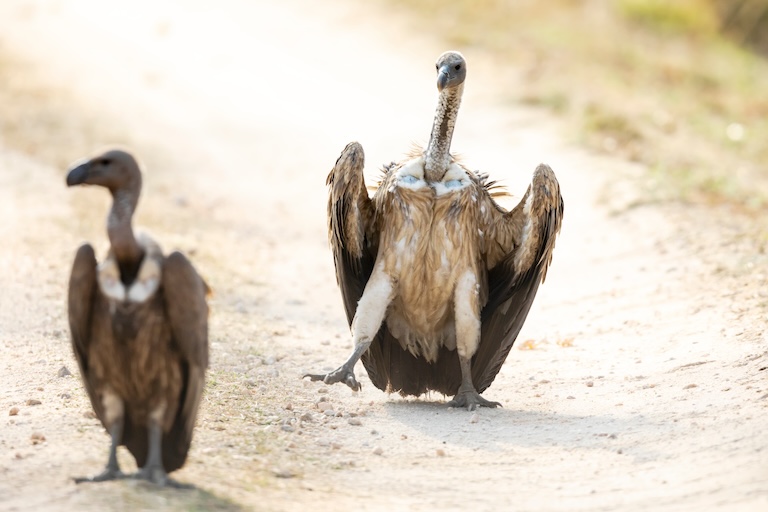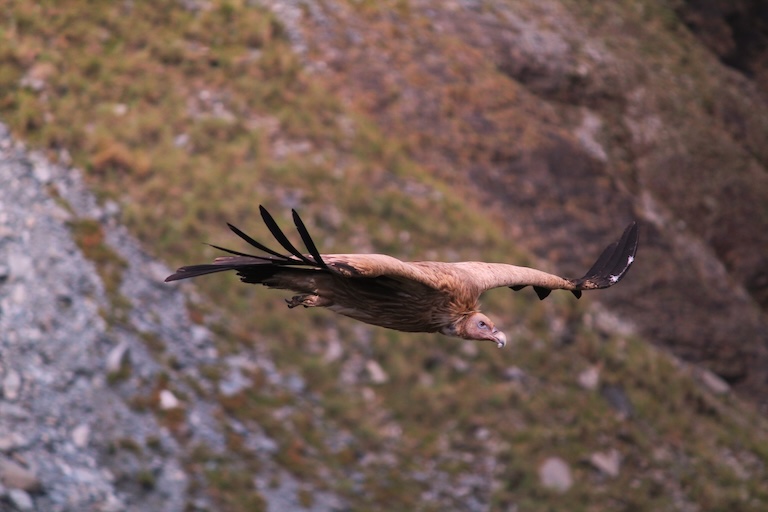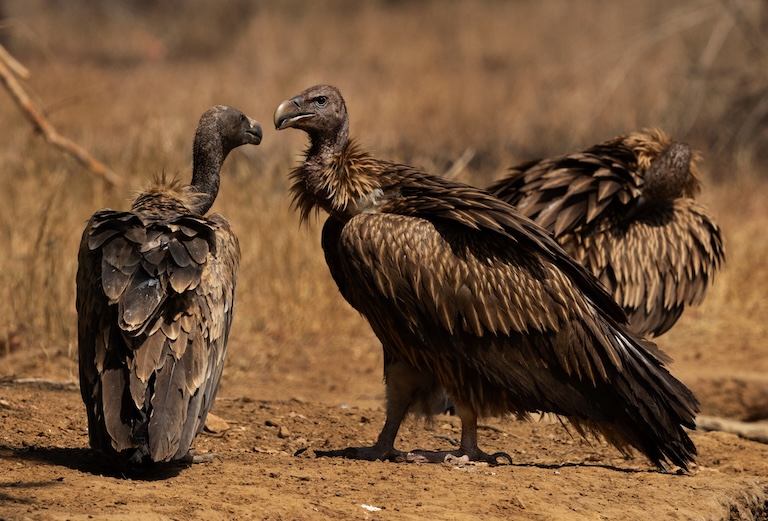Indian Vulture Profile
In Parsi Zoroastrian tradition, an individual’s final act of generosity is to donate their body to the Tower of Silence, a monolithic platform from which the local vultures can feed on the dead.
This gesture serves more than a spiritual purpose, it’s also a key act in preventing diseases; something which in the 1990s became a serious threat when the regular vulture population tanked to astonishing lows.
The resident Indian vultures, who like to eat in-place, and had safeguarded this practice since the dawn of civilisation, were poisoned almost to extinction, and in their wake, the few scavengers that remained preferred to carry large chunks of their food away and eat them in private.
The result was a ‘redistribution’ of human body parts across densely-populated cities, threatening to undo almost 12,000 years of tradition and drop Aunty Divya’s half-rotten left foot in the family soup (may she rest in peace).

Indian Vulture Facts Overview
| Habitat: | Semi-desert, dry foothills, cultivated land |
| Location: | India |
| Lifespan: | 45 Years |
| Size: | 103 cm (41 in) long 2.58 m (8 ft 6 in) wingspan |
| Weight: | 6.3 kg (14 lb) |
| Colour: | Grey/brown |
| Diet: | Carrion |
| Predators: | None |
| Top Speed: | 35 km/h (22 mph) |
| No. of Species: | 1 |
| Conservation Status: | Critically Endangered (IUCN) |
Indian vultures are incredible-looking birds. Large, powerful carrion-feeders with long beaks and characteristic hunched shoulders.
They have a brow ridge that helps them keep the sun out of their eyes while circling for corpses and are experts at riding the thermal currents to high altitudes.
They’ve played an irreplaceable role in human and wider ecosystems for thousands of years, and this has never been more evident than when their numbers crashed from mass poisonings in the ‘90s.
Thankfully there’s a good chance the species can be saved and brought back to its former glory.
Interesting Indian Vulture Facts
1. They’re griffon vultures
The genus Gyps contains some of the most epic vultures. These are the Old World vultures, which means they live in countries white people have known about for longer.
Africa, Asia and Europe are home to this genus, and as the name suggests, the Indian vulture is from Southern Asia. Like all griffon vultures, they’re slender-necked with a ruff and have a fantastic mean mug going on.
2. Their necks are like scrota
Many mammals have solved the problem of thermoregulation of the male reproductive organs by housing them in an extendible sack which can be brought up in cold (or frightening) environments and can be allowed to hang precariously away from the heat of the body when things are getting too steamy.
Similarly, the Indian vultures handle swings in temperature by extending or retracting their bald necks, housing them inside a fluffy ruff of neck feathers when it’s too cold and letting them dangle in the wind like a worn-out, leathery old speedbag in the hottest part of the day.
They’ll also cool themselves by opening their huge wings, which make them look like a sort of evil wizard, but it is very good for avoiding the effects of the midday sun.
This bare neck also helps prevent the build-up of rotting flesh and body fluids on the feathers of the neck and head, an adaptation to sticking their beaks up the bum holes of dead cattle and such. 1

3. They’re efficient
These wings are also specially designed for gliding, which saves hugely on energy bills, as it makes use of the thermal updrafts to create lift instead of laboriously flapping like all the other suckers.
Indian vultures soar at up to 35 km/h in this manner and barely have to lift a feather to do it. Nesting high on cliffs, they can simply open their wings to the wind and allow it to pluck them off the rocks when taking off.
This method is efficient enough for the vulture to travel hundreds of miles in a day when foraging.
4. They’re a keystone species
Vultures are commonly regarded as low-down dirty scavengers, but it is exactly this that makes them so important to the health of our ecosystems (and therefore our health).
When things die (or poo), the remains don’t just rot away to nothing; it’s important to remember that there is a multitude of organisms responsible for facilitating their removal. When the Pope shits in the woods, whether we are there to hear it or not, thousands of little beetles, worms, and microbes (and sometimes, unfortunately, your pet dog) will start eating away at it until it’s removed from the woods and returned redistributed throughout the ecosystem.
This, as you can imagine, is an invaluable service. You only have to look at what happens to the office toilets in the space of a single shift when the cleaning staff go on strike, to understand how an under-appreciated and thankless job can be so significant to your wellbeing.
Similarly, when vultures eat a corpse, they’re taking away what would otherwise be quite unpleasant to be around, and turning it into a fertiliser that everyone can benefit from. As a result of this, and the fact that there aren’t many other animals as willing to eat rotting flesh, these birds are essential to the support of the thousands of species they share a habitat with, including humans.
And this is what a keystone species is: an organism whose existence links the entire arch of life together and consequently, whose eradication risks the entire thing collapsing.

5. The entire thing is collapsing
This species is now Critically Endangered after a wave of diclofenac poisoning reduced the population in a catastrophic crash.
Bodies of these vultures were showing up all over India and Pakistan, killed by gout as a result of the fatal reaction to a common anti-inflammatory used in livestock.
It’s safe in many mammals, but it’s lethally toxic to vultures and has been the cause of widespread collapses in populations of many species as a result.
As a result, thousands of human deaths have been attributed to the effects of rotting carrion in the ecosystem and the diseases that this can spread. Water sources are being contaminated and, in their place, feral dog populations bloomed, bringing with them rabies and other lovely diseases.
It’s estimated that human mortality rates increased by as much as 4% during the peak of the decline from 2000 to 2005, with 47,000 deaths attributed to the increase in rabies.
Due to the decline in vultures, the Parsi community have been forced to abandon their ancient traditions in favour of more hygienic ones. 2

6. They can make a comeback
The Parsis reached out to the international community for help bringing the species back, and in 2006, India banned diclofenac, replacing it with Meloxicam which is a lot easier for the birds to metabolise.
They also reduced the amount of drugs that are legal to administrate, and almost immediately, the population rebounded.
They’re by no means out of the woods yet – they’re still classified as critically endangered by the IUCN – and a lack of enforcement means diclofenac is still on the market to a lesser degree, and these slow-breeding birds are taking their sweet time to reproduce in captivity.
Still, as the crackdown on diclofenac and other similar toxins improves, the species could see a complete recovery.
Indian Vulture Fact-File Summary
Scientific Classification
| Kingdom: | Animalia |
| Phylum: | Chordata |
| Class: | Aves |
| Order: | Accipitriformes |
| Family: | Accipitridae |
| Genus: | Gyps |
| Species: | Indicus |
Fact Sources & References
- Nadim Chishty (2020), “Seasonal Fluctuation in Thermoregulatory Behaviour of Long-Billed Vulture (Gyps indicus) by Wing Stretching at Southern Rajasthan, India”, Current World Environment.
- (2021), “Indian Vulture”, IUCN Red List.
